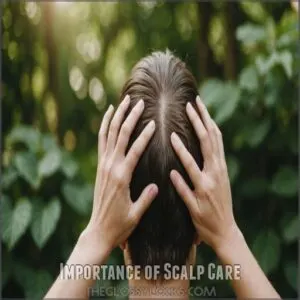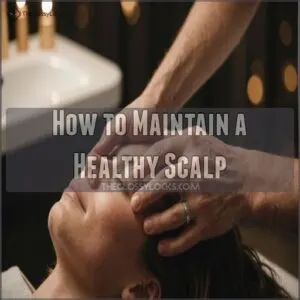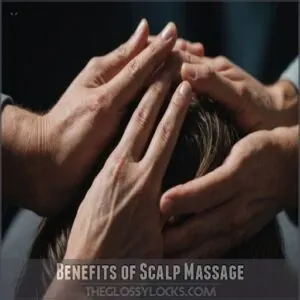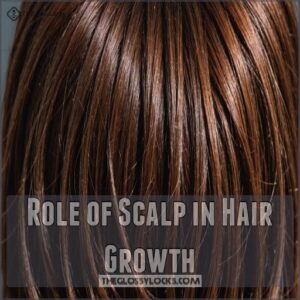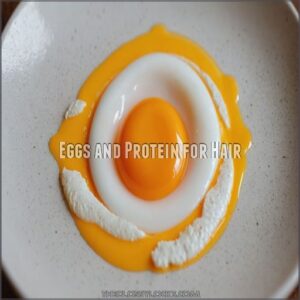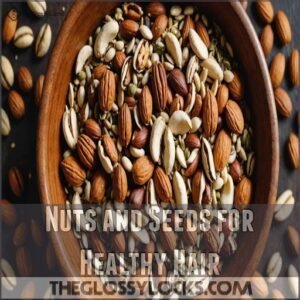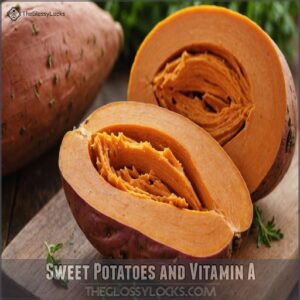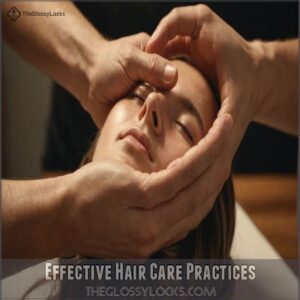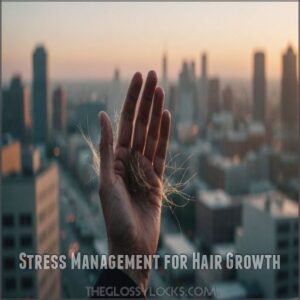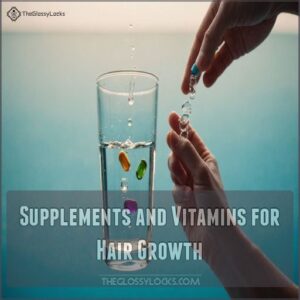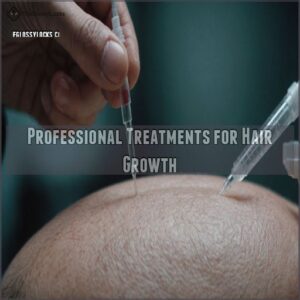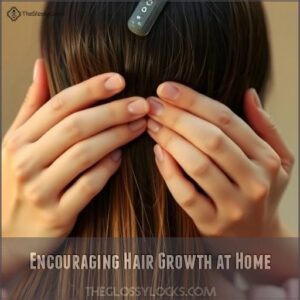This site is supported by our readers. We may earn a commission, at no cost to you, if you purchase through links.
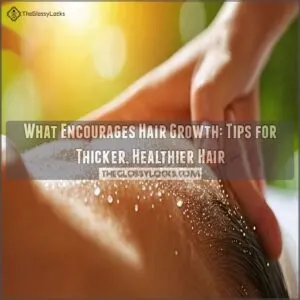 Your hair growth journey doesn’t have to feel like watching paint dry!
Your hair growth journey doesn’t have to feel like watching paint dry!
You’ll see real results by focusing on what science shows encourages hair growth: proper nutrition, scalp care, and stress management.
Pack your diet with protein-rich foods, omega-3 fatty acids, and biotin-rich eggs.
Keep your scalp happy with gentle massages and avoid harsh chemical treatments.
You’re also fighting an internal battle – high stress levels can literally push hair into its resting phase.
While there’s no magic potion, combining these evidence-based strategies creates the perfect environment for those follicles to thrive.
And wait until you learn about the surprising connection between your morning coffee and hair growth.
Table Of Contents
- Key Takeaways
- Healthy Scalp for Hair Growth
- Nutrient-Rich Foods for Hair Growth
- Effective Hair Care Practices
- Stress Management for Hair Growth
- Supplements and Vitamins for Hair Growth
- Professional Treatments for Hair Growth
- Encouraging Hair Growth at Home
- Frequently Asked Questions (FAQs)
- How can I improve my hair growth?
- What foods are beneficial for hair growth?
- How can a healthy scalp improve hair growth?
- How to stimulate hair growth at home?
- Does hair care really boost hair growth?
- What supplements help with hair growth?
- How can I encourage my hair to grow?
- What triggers hair growth?
- Is there anything that stimulates hair growth?
- What naturally supports hair growth?
- Does sleeping position affect hair growth and thickness?
- Can certain weather conditions slow down hair growth?
- How do hormonal changes impact natural hair growth?
- Does frequent hair washing increase or decrease growth?
- Can physical exercise boost hair growth speed?
- Conclusion
Key Takeaways
- Regular scalp massages with ghee, which has numerous benefits for hair growth, can also help prevent hair loss and improve circulation to the follicles. You’ll boost hair growth by maintaining a healthy scalp through gentle massages, regular cleansing, and avoiding harsh chemical treatments.
- Your diet plays a crucial role – focus on protein-rich foods, omega-3 fatty acids from fatty fish, and biotin from eggs to nourish hair follicles.
- You can reduce hair loss by managing stress through regular exercise, meditation, and getting 7-8 hours of quality sleep.
- You’ll see better results by minimizing heat styling, using gentle hair care products, and getting regular trims to prevent breakage and split ends.
Healthy Scalp for Hair Growth
You might think of your scalp as just a hat for your hair, but treating it right is key to encouraging hair growth.
By keeping your scalp healthy, you can create a nourishing environment that supports hair follicles and promotes stronger, thicker strands.
Importance of Scalp Care
Picture your scalp as the fertile ground for a flourishing garden.
Scalp health is the unsung hero behind lush locks, ensuring your hair’s environment is just right for growth.
Neglecting it can lead to dryness, irritation, and unwanted hair issues.
Embrace scalp hygiene, and consider adding a gentle scalp massage to your routine—it’s like a spa day, but for your head!
How to Maintain a Healthy Scalp
A healthy scalp’s the foundation for great hair.
So, how do you keep it happy?
Gentle cleansing is key—avoid harsh shampoos that strip away natural oils.
Consider using a scalp serum treatment to nourish your scalp.
Condition regularly to keep it hydrated.
Once a week, treat yourself to a scalp scrub for a deep clean.
Think of it as a facial for your head!
These simple steps promote scalp health and better hair growth.
Benefits of Scalp Massage
By boosting blood flow to the hair follicles, scalp massages can supercharge your hair growth.
Tension melts away, and with it, stress—which can sometimes be a hair growth enemy.
Ready to give it a try? Try these:
- Use fingertips in circular motions.
- Incorporate essential oils for extra oomph.
- Make it a daily ritual.
- Enjoy the relaxation!
Role of Scalp in Hair Growth
Understanding your scalp’s role in hair growth is like cracking a secret code.
Your hair follicles thrive with healthy blood flow and nutrition, which a scalp massage boosts.
Imagine the scalp as the soil—nurture it well, and you’ll see lush hair.
A healthy scalp minimizes hair loss and promotes growth naturally, and utilizing natural hair growth remedies at home, such as aloe vera gel for scalp, can help in achieving that. A healthy scalp minimizes hair loss and promotes growth naturally.
| Key Element | Impact | Benefit |
|---|---|---|
| Scalp Health | Essential | Encourages hair growth |
| Hair Follicles | Nurtures | Important for hair strength |
| Blood Flow | Stimulates | Enhances nourishment |
| Scalp Massage | Relaxes | Reduces hair loss |
| Hair Loss | Manages | Promotes thicker hair |
Nutrient-Rich Foods for Hair Growth
Eating the right foods can give your hair the nutritious boost it needs to grow thick and strong, just like a superhero on a mission!
Incorporating fatty fish, eggs, and dark leafy greens into your diet helps your hair get essential nutrients like omega-3s, protein, and iron, keeping it in tip-top shape.
Fatty Fish and Omega-3 Fatty Acids
Reeling in the benefits of omega-3 can give your hair a boost.
Foods like salmon aren’t just tasty but packed with these fatty acids that combat hair loss.
Think of omega-3 as the secret sauce for a shiny mane.
Fish oil supplements can help too!
Start incorporating dietary omega-3 to keep your locks luscious and strong.
Eggs and Protein for Hair
If you’re worried about hair loss, eggs are your secret weapon.
Packed with protein, they rebuild and strengthen hair follicles.
Think of them as little powerhouses!
For those looking to supplement their diet, consider browsing protein hair supplements to support your hair care journey.
Don’t ignore that yolk—it’s rich in essential nutrients that nourish your scalp.
Include eggs in your diet to kickstart hair growth and make sure you’re not facing a protein deficiency.
Dark Leafy Greens and Iron
After eggs, let’s tackle dark leafy greens.
Spinach and kale aren’t just for salads; they’re your hair’s secret sauce!
Rich in iron, they combat hair loss linked to anemia.
Here’s your action plan:
- Toss them into smoothies.
- Sauté them with garlic.
- Sneak them into soups.
Your hair will thank you, no strands pulling a disappearing act.
Nuts and Seeds for Healthy Hair
Iron’s great, but let’s talk nuts and seeds! They’re packed with nutrients rich in vitamin B5 benefits for hair growth (Vitamin B5 Benefits) that boost hair growth. Think of them as tiny powerhouses for your locks.
| Nut/Seed | Hair Growth Benefits | Recipe Ideas |
|---|---|---|
| Almonds | Vitamin E, healthy fats | Almond butter smoothie |
| Chia Seeds | Omega-3s, fiber | Chia seed pudding |
| Pumpkin Seeds | Zinc, magnesium | Sprinkle on salads or yogurt |
These little guys help keep your scalp and hair healthy, contributing to strong, shiny hair. So sprinkle them in your diet!
Sweet Potatoes and Vitamin A
Think sweet potatoes are just for the holidays? Think again!
Packed with Vitamin A, these tasty tubers can be a hair hero.
Vitamin A benefits include:
- Promoting scalp oils, giving you a natural sheen.
- Fighting Vitamin A deficiency, reducing hair loss.
- Making hair growth myths forgettable by boosting follicle function.
Sweet potato recipes are a scrumptious way to support luscious locks!
Effective Hair Care Practices
In terms of encouraging hair growth, adopting effective hair care practices like trimming regularly and using the right products can work wonders.
You wouldn’t believe how simple changes, such as skipping the heat styling and embracing regular scalp scrubs, can help keep your hair healthier and thicker.
Trimming and Breakage Prevention
Hair splitting like an overcooked spaghetti strand? Regular trims keep those pesky split ends in check! Trimming every 6-8 weeks stops breakage dead in its tracks, keeping your ends healthy and strong. Meanwhile, enjoy a good laugh at how your hair defies gravity like a cartoon anvil falling off a cliff. It’s all about the bouncy, fresh look!
| Benefit | Trim Frequency | Result |
|---|---|---|
| Less Breakage | Every 6-8 weeks | Stronger hair |
| Fewer Split Ends | Regular trimming | Healthier appearance |
| Easier Styling | Consistent cuts | Manageable hair |
| More Volume | Scheduled trims | Fuller look |
| Reduced Damage | Frequent clips | Long-lasting style |
Importance of Conditioner and Shampoo
You’ve already learned about trimming to dodge split ends, but let’s chat about keeping your scalp happy.
Using shampoo wisely – not too often, ideally every 2-3 days for most adults – keeps product buildup at bay and prevents hair damage, as seen in guides on how often to wash hair.
Pair it with the right conditioner type for scalp hydration.
Treat your hair like a plant: balanced nutrients and care make it flourish!
Avoiding Heat Styling and Chemical Treatments
Conditioner keeps your hair hydrated.
But there’s more: skipping the heated styling tools and harsh chemical treatments can also help keep your hair healthy!
When you say "no" to frequent blow-drying or flat-ironing, you let natural textures shine, prevent damage, and favor chemical-free hair care.
Try:
- Air drying
- Loose braids
- DIY hair masks
- Protective hairstyles
Benefits of Regular Scalp Scrubs
Give your scalp a little TLC with regular scrubs.
Think of it as a mini spa day for your head!
This exfoliates dead skin, boosts scalp health, and clears product buildup.
Exfoliation benefits include improved blood circulation, leading to better hair growth.
Need more convincing?
Here’s a quick pros and cons:
| Pros | Cons |
|---|---|
| Stimulates growth | Can be messy |
| Refreshes scalp | Requires time |
| Removes flakes | Needs technique |
| Boosts circulation | Costs money |
Stress Management for Hair Growth
Stress can wreak havoc on your hair, even leading to hair loss, so managing it’s key for healthy growth.
Exercise, meditation, and sufficient sleep can help you keep your cool and your hair looking its best.
Impact of Stress on Hair Growth
Chronic stress can wreak havoc on your hairline, with stress hormones disrupting growth and leading to stress-related hair thinning.
Imagine stress as a sneaky hair thief.
But don’t fret! Stress management techniques, like meditation or deep breathing, can be your secret weapon.
Remember, laughter’s great medicine—let humor lighten the stress load and keep your locks thriving.
Exercise and Hair Growth
When stress takes a toll on your hair, exercise steps in like a hero.
It boosts blood flow, delivering nutrients to the scalp and paving the way for growth.
Plus, it keeps stress in check.
Consider these activities:
- Morning walks: Nature’s best motivator.
- Yoga: Stretch for peace.
- Dance: Groove your worries away.
- Cycling: Cycle stress off your scalp.
Meditation and Stress Reduction
Just like regular exercise boosts energy, meditation and stress reduction strengthen your hair’s resilience.
By understanding your hair’s growth cycle, particularly the anagen growth phase, you can take a more informed approach to promoting growth.
Through mindfulness, breathing exercises, and yoga, you lower stress levels—less stress means less hair shedding.
Picture a stress-free lifestyle as a garden nourishing your follicles.
Embrace these relaxation techniques, and you’ll foster healthier hair growth while enjoying some peace of mind.
Importance of Sleep for Hair Growth
While you’re catching those precious Z’s, your body’s working overtime on hair growth.
During deep sleep, your system releases growth hormones and repairs cells, including those in your hair follicles.
Getting 7-8 hours of quality sleep helps balance stress hormones like cortisol, which can otherwise interfere with hair growth.
Plus, consistent REM sleep cycles keep your body’s natural hair growth rhythm in sync.
Supplements and Vitamins for Hair Growth
If you’re dreaming of thicker, healthier hair, you’ll be glad to know that the right supplements can help fill the nutritional gaps in your diet.
Using natural oils like castor oil for hair rich in vitamin E and fatty acids can help nourish and strengthen hair. When combined with a balanced diet, nutrients like biotin, vitamin D, zinc, and omega-3s work together like a dream team to support your hair’s natural growth cycle.
Benefits of Biotin and Vitamin B12
Your hair’s health depends heavily on B-vitamins, especially biotin and B12.
These powerhouse nutrients help create red blood cells that carry oxygen to your follicles.
Biotin strengthens hair structure and reduces breakage, while B12 helps form new hair cells.
If you’re struggling with thinning hair, consider getting your B-vitamin levels checked – a simple supplement might be your ticket to thicker locks.
Role of Vitamin D in Hair Growth
Getting enough vitamin D isn’t just about strong bones – it’s essential for healthy hair growth too.
Research shows that vitamin D receptors in hair follicles play a key role in the growth cycle.
Prenatal vitamins for hair growth, like those containing vitamin D, can help reduce shedding and thinning, common side effects of pregnancy hormones.
Low vitamin D levels often show up as noticeable hair thinning, and some studies suggest that prenatal hair growth supplements may be beneficial in supporting hair health.
Just 15-20 minutes of sunlight can boost your levels naturally, fatty fish and egg yolks pack a vitamin D punch, mushrooms exposed to UV light are an excellent source, and a doctor can test your levels and recommend supplements if needed.
Importance of Iron and Zinc Supplements
Iron and zinc play a key role in maintaining healthy hair growth.
If you’re experiencing hair loss, low iron levels might be the culprit – it’s especially common in women.
A blood test can confirm if you need iron supplements.
Zinc helps repair hair tissue and keeps oil glands around follicles working properly.
Before starting supplements, check with your doctor for proper dosage recommendations.
Benefits of Omega-3 Fatty Acids and Antioxidants
Omega-3 fatty acids work like natural hair fertilizers, nourishing follicles from within.
When you combine these healthy fats with antioxidants, you’re giving your hair a powerful growth boost.
Studies show that omega-3s can make hair thicker and reduce shedding, while antioxidants fight free radicals that slow growth.
Try adding fatty fish to your diet and consider a supplement if you don’t eat fish regularly.
Professional Treatments for Hair Growth
If you’re struggling with hair loss, consulting a dermatologist can open up a world of proven treatments that go beyond your typical drugstore solutions.
From incorporating holistic approaches like Ayurvedic hair growth treatments that address underlying imbalances, to FDA-approved medications like Rogaine to cutting-edge options like hair transplantation and light therapy, you’ll find professional treatments backed by science to help restore your hair’s natural growth and thickness.
Hair Transplantation and Its Costs
Hair transplantation offers a permanent solution for thinning hair, but it’s not cheap.
You’re looking at around $10,000 for the procedure, which involves moving healthy follicles to sparse areas.
While the cost might make your wallet wince, many find it worth the investment.
Recovery takes about two weeks, and you’ll see full results within a year.
Insurance typically won’t cover it, so plan accordingly.
Minoxidil (Rogaine) for Hair Growth
Anyone seeking a proven hair growth solution should consider Minoxidil, the active ingredient in Rogaine.
You’ll find it in both foam and liquid forms, with options for men and women.
When applied twice daily to your scalp, it works by extending your hair’s growth phase and increasing follicle size.
While results vary, most people notice improvement within 3-6 months of consistent use.
Peppermint Oil for Hair Growth
A diet rich in essential nutrients, including a hair growth diet for men, can help promote a healthy scalp and encourage thicker hair. Several studies suggest that peppermint oil can boost hair growth without unwanted side effects.
When applied to your scalp, it creates a cooling sensation that improves blood flow to hair follicles.
For those looking for a more convenient option, peppermint oil scalp treatments are also available online through peppermint oil products.
- Mix 2-3 drops with your regular shampoo or carrier oil
- Apply directly to your scalp twice weekly
- Massage gently for 3-5 minutes to stimulate circulation
Remember to patch test first – some folks might experience sensitivity.
Benefits of Light Therapy for Hair
Light therapy opens up new possibilities for hair regrowth, working like spring sunshine to wake up dormant follicles.
Red light therapy penetrates your scalp to energize cells and boost circulation, while low-level laser treatments can kick-start your natural hair growth cycle.
You’ll typically need 2-3 sessions weekly, and while it’s not cheap, many users see noticeable results within 3-4 months of consistent use.
Encouraging Hair Growth at Home
You don’t need fancy treatments or expensive products to encourage healthy hair growth at home.
With simple techniques like scalp massage and natural oils, plus smart choices about heat styling and supplements, you’ll boost your hair’s natural growth cycle while saving money on salon visits.
DIY Scalp Massage for Hair Growth
Three minutes of daily scalp massage can boost your hair growth by increasing blood flow to follicles.
You don’t need fancy tools – your fingertips work perfectly.
Start at your hairline and work in circular motions toward the crown, applying gentle pressure.
For best results, massage when your scalp’s clean and do it consistently.
Many people find it relaxing before bed.
Using Essential Oils for Hair Growth
Natural oils pack a punch when it comes to boosting your hair growth.
After your scalp massage, try these powerhouse oils that’ve been backed by research:
- Rosemary oil stimulates blood flow like minoxidil
- Peppermint oil tingles and wakes up sleepy follicles
- Lavender oil calms your scalp and reduces inflammation
- Tea tree oil keeps your scalp clean and happy
Mix a few drops with coconut oil for best results.
Benefits of Keratin and Collagen Supplements
While essential oils can work wonders, supplements pack an extra punch for hair growth.
Keratin supplements strengthen your hair’s structure from within, making it less prone to breakage.
Collagen supports hair strength and thickness by providing amino acids your body needs.
You’ll notice both supplements also improve your skin and nails – it’s like getting a beauty boost from the inside out!
Reducing Heat Styling for Hair Growth
Hot tools might seem like your hair’s best friend, but they’re secretly working against your growth goals.
After protecting your hair with supplements, let’s focus on heat-free styling.
Here’s how to break up with your hot tools:
- Air-dry hair using microfiber towels
- Try heatless curls with silk scarves overnight
- Master protective styles like braids and twists
- Embrace your natural texture with styling creams
Frequently Asked Questions (FAQs)
How can I improve my hair growth?
Boost your hair growth by massaging your scalp daily, eating protein-rich foods, and taking biotin supplements.
Avoid tight hairstyles and use gentle hair care products to prevent breakage.
Keep stress low.
What foods are beneficial for hair growth?
Protein-rich foods like eggs, fish, and lean meats support healthy hair.
You’ll also want plenty of leafy greens, nuts, and fruits packed with vitamins A, C, and E for stronger, shinier locks.
How can a healthy scalp improve hair growth?
A healthy scalp creates the perfect environment for hair growth.
You’ll want to keep it clean, well-moisturized, and free from buildup.
Regular massages boost circulation, delivering essential nutrients to your follicles.
How to stimulate hair growth at home?
Despite what you’ve heard, you don’t need fancy products to boost growth.
Massage your scalp daily, use gentle shampoos, trim regularly, and eat foods rich in vitamins.
Avoid tight hairstyles and heat styling.
Does hair care really boost hair growth?
Yes, proper hair care has a big impact on growth.
You’ll see better results by maintaining a healthy scalp, using gentle products, and avoiding harsh treatments.
Regular trims and scalp massages also support natural growth cycles.
What supplements help with hair growth?
Several supplements can boost your hair growth: biotin aids protein breakdown, vitamin D supports follicle health, zinc helps tissue repair, and omega-3s reduce inflammation.
Always check with your doctor before starting supplements.
How can I encourage my hair to grow?
Tired of waiting for those locks to grow?
Focus on scalp health with gentle massage, proper nutrition, and stress management.
Avoid harsh treatments and opt for regular trims while keeping your hair and scalp moisturized.
What triggers hair growth?
Hair growth is triggered by proper nutrition, good blood circulation, and healthy hormone levels.
You’ll see better results when you maintain a balanced diet, massage your scalp regularly, and manage stress effectively.
Is there anything that stimulates hair growth?
You can boost hair growth through scalp massage, nutrient-rich foods, and supplements like biotin. Regular use of minoxidil, proper scalp care, and stress management also stimulate healthy hair growth naturally.
What naturally supports hair growth?
Nourish those locks with omega-rich foods, scalp massages, and gentle hair care. You’ll boost growth naturally through stress management, proper nutrition, and avoiding harsh chemicals that damage your precious strands.
Does sleeping position affect hair growth and thickness?
Sleeping on silk or satin pillowcases can prevent hair breakage and tangling.
While position doesn’t directly affect growth, lying on your back reduces friction that could damage strands and weaken follicles.
Can certain weather conditions slow down hair growth?
Cold weather can slow hair growth by constricting blood vessels in your scalp.
While extreme heat and humidity may cause damage and breakage.
Your hair typically grows slower in winter months than summer.
How do hormonal changes impact natural hair growth?
Think your hormones aren’t affecting your hair? Think again.
Your body’s hormonal shifts, especially during pregnancy, menopause, or thyroid changes, can greatly impact your hair’s growth cycle, thickness, and overall health.
Does frequent hair washing increase or decrease growth?
Washing your hair 2-3 times a week is ideal for growth.
Over-washing strips natural oils that protect your scalp and follicles, while under-washing can clog pores.
Find your sweet spot based on your scalp type.
Can physical exercise boost hair growth speed?
Exercise boosts blood circulation to your scalp, delivering more oxygen and nutrients to hair follicles.
Working out reduces stress hormones that can slow hair growth.
You’ll see better results with consistent activity.
Conclusion
Growing luscious locks isn’t about quick fixes – it’s about playing the long game.
By now you’ve discovered what encourages hair growth: a combination of proper nutrition, gentle scalp care, and stress management.
Think of your hair journey like tending a garden – give it the right nutrients, care, and patience, and you’ll see results.
Remember, healthy hair starts from within, so make these habits part of your daily routine.
Your future self (and your hair) will thank you.

